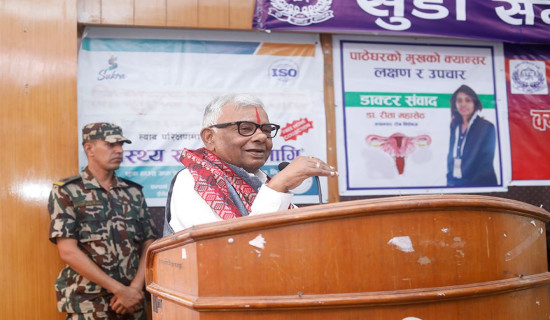- Saturday, 14 June 2025
Reinvigorate Provincial Governments
With the adoption of the federal structure, the administrative structure of Nepal is now based on three tiers of governance: federal, provincial and local governments. The Constitution of Nepal, promulgated in 2015, provides for this system of governance. And the Constitution has provision for provincial governments in all the seven provinces.
The provincial governments are sub-national governments. They are supposed to allow people to exercise sovereign rights through elected people’s representatives, besides contributing to democratic, representative, just and inclusive political system. Their basic thrust is to facilitate service delivery for the people living in their respective provinces without having to depend on the federal government. In a unitary system of governance, all the sovereign powers are exercised by the central government and only a limited number of people are involved in governance and decision-making.
Participation
Provision for the provincial governments ensures that a number of people are involved in governance and decision-making and that various aspirations of the people – political, regional, social, cultural, economic and ethnic – are addressed through their participation in governance and decision-making. This means the central government cannot unilaterally impose its decisions on the people having different political, social, economic, cultural, religious, ethnic and other backgrounds.
The provincial governments are provided with exclusive powers such as provincial police administration, law and order, civil service, statistics, higher education and university management, land management, protection of languages, cultures and traditions and management of trusts. Besides, they also have concurrent powers in certain areas, which are exercised together with the federal and local governments. The provincial governments are provided for in the Federal Constitution in such a manner that they are not under the control of the federal government. Also, the local bodies are under the control of neither the provincial governments nor the federal government. The provincial governments are autonomous to collaborate with the local bodies and the federal government in certain areas.
Elections have been held to the federal and provincial governments twice since the promulgation of the constitution. But even not all the necessary laws have been formulated. Laws have, however, been framed for certain areas such as provincial police administration, civil service, higher education and taxation. In the beginning, the provincial governments were literally taken aback as to how to work. They had to struggle to even form governments. They spent much time and energies in naming themselves and choosing their headquarters.
The provincial governments are not the branches of the federal government. But they are directly controlled by the political parties or leaders at the centre. The constitutional provision of political parties provides for the operation of political parties, but there is no provision for the federation of political parties. This is one of the drawbacks for the provincial governments. The political parties at the centre choose leaders for the provincial governments. That is why, the provincial governments cannot make any decisions that do not commend themselves to the federal leaders or that go against their interests. The operation of the provincial governments is centralised, which has impeded their performance and efficiency and put their autonomous status on the line.
Since the formation of the provincial governments after the 2022 federal and provincial elections, they have changed several times. This shows that they are facing political instability. At the federal level, the CPN-Maoist Centre, the CPN-UML and some other parties formed a government immediately after the elections. The CPN-UML supported CPN-Maoist Centre chair Pushpa Kamal Dahal ‘Prachanda’ as Prime Minister. And the coalition culture also spread to the provincial governments.
However, the coalition government collapsed soon and the CPN-Maoist Centre, the Nepali Congress and other political parties formed an alliance. The alliance then formed a coalition government. Now, this very alliance has collapsed, giving rise to another alliance involving the CPN-UML again. This has affected the provincial governments as well. There may be unhealthy exercises to change some provincial governments. Three provincial chiefs affiliated to the Nepali Congress have recently been replaced by the ones associated with the -UML.
Direct interference of the federal leaders in the affairs of the provincial governments is not desirable. The provincial governments should be treated as autonomous bodies. They should be allowed to operate, taking into consideration the aspirations of the people living in their jurisdictions. The provinces should be allowed to form or dissolve their governments as per their needs. Giving autonomy to the provincial governments will help enhance their performance. The leaders at the centre are treating the provincial governments as puppet governments. This is an unfortunate state of affairs and goes against the spirit of federalism.
Additional expenses
The people are not satisfied with the performance of the provincial governments. The provinces are entangled in forming and dissolving governments instead of working for the welfare of the people. The provincial governments are focused on sustaining themselves rather than paying heed to fulfilling the aspirations of the people. The people have grown so disillusioned with the provincial governments that some have gone as far as to say that the provincial structure should be dissolved as the federal and local strictures are enough for overall administration.
With the provision for the provincial structure, the government has also to make additional expenses for many members of the provincial parliaments. It may be noted that at one time, the government faced difficulty paying salaries to the civil servants and police and military personnel. The provincial governments have made a dent in the state coffers. However, if they work effectively and efficiently, they can generate revenue for themselves as well as for the state. So it is high time the government made concrete steps towards revamping and reinvigorating the provincial governments.
(Maharjan has been regularly writing on contemporary issues for this daily since 2000.)












-original-thumb.jpg)




